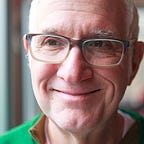It’s time for us to have “the talk” about COVID-19 and the need to stay the social distancing course
I think it’s time we sat down and had “the talk,” the facts of life talk, that is. In this case, it’s going to be the facts of life under COVID-19. Yes, it’s going to make us both a bit uncomfortable, but, after all is said and done, it’s better to confront the biological realities of the world head-on.
The single most important biological fact of life under COVID-19 is that the virus isn’t going away anytime soon. This observation seems to be missing from the ongoing debate about whether and how we should proceed to reopen society so that our lives can get back to a semblance of the way they were a few months back. Much of the public discussion is motivated by the perception that, in New York Governor Andrew Cuomo’s word, “the worst is over.” Some people take that to mean that it is time to sound the all-clear. It is not.
What Governor Cuomo, a hero of the hour by anyone’s reckoning, meant with his declaration is that New York State appeared to have endured the first wave of COVID-19 infections without totally overwhelming its healthcare system. This good news is admittedly a cause for some celebration, but not a cause for letting our guards down when it comes to preparedness and continued social distancing.
Just because we have dodged one COVID-19 bullet, doesn’t mean that there aren’t more bullets heading our way. And this virus still has plenty of bullets left for us in its bandolier.
The salient — and largely unspoken — reality is that the COVID-19 virus will continue to spread through the population until a level of “herd immunity” is established which deters its further advances. This not speculation, it is a mathematical fact. Herd immunity within a population is acquired when the probability of passing a contagious agent like a virus from one person to the next is so low that it stifles the possibility of any significant additional transmission.
Well, it sounds like this herd immunity is a “good thing,” doesn’t it. So why don’t we get to work making it happen?
The preferred way to establish herd immunity is to vaccinate people against a disease, both making them immune to infection and denying that disease the opportunity to use those vaccinated people as carriers to extend its reach to uninfected individuals. Sadly, with COVID-19, we’re not going to see a thoroughly tested, widely available vaccine for at least a year or two. So much for the easy road to herd immunity.
The less desirable way to establish herd immunity is the old-fashioned way: let people become infected. As with most viral illnesses, it appears that, once someone is infected with this coronavirus and recovers, if they become ill at all, that person not only becomes immune to the disease, but also, after a short period of time, is removed from the pool of potential carriers.
But the problem with this path to herd immunity is obvious: when many people get infected COVID-19, some fraction of them will become ill enough to require hospitalization, and, some fraction of that number will die or suffer lifelong debilitation resulting from the disease itself or from the desperate medical interventions needed to keep them alive.
These are the two paths to herd immunity — either vaccination or widespread infection — and they are the only ways we will ultimately wrestle COVID-19 to the mat.
Believe it or not, social distancing doesn’t change the calculus of herd immunity one wit. What it does do is to allow us to reduce how quickly COVID-19 spreads through the population, thus enabling us, like the hero Neo in the Matrix movies, to dodge a barrage bullets heading our way.
In particular, social distancing helps us to keep our healthcare system from being overwhelmed by a demand for, among other things, ICU beds and hospital ventilators. Needless to say, these measures also offer much needed relief for frontline healthcare workers already pushed beyond limits in their brave efforts to say the lives of their patients.
What is more, social distancing buys us invaluable time to engage in much needed research and development. As mentioned above, some of this R&D has to do with creating a safe and effective vaccine, although such a godsend is further down the pike than we would prefer.
But that same precious time can be used to develop treatments for COVID-19, some based on already approved drugs, that can be brought to bear much sooner to help patients struggling with the most severe symptoms of the disease. These treatments, when they arrive, will do double duty; by helping to keep COVID-19 from progressing further in severely ill patients, they also will help free up desperately needed hospital resources to support those who will require the most urgent and intense medical care.
As they say, there’s no fooling mother nature. In this case, it might be said there’s no fooling herd immunity. Like it or not, the laws of epidemiology have us headed toward eventual herd immunity one way or the other. We can get there either the hard way by just having lots of people get infected with COVID-19 sooner or the easier way by maintaining our vigilance until better treatments and a vaccine are developed while keeping the demands placed on our healthcare system — not to mention the demands placed on all our essential service workers — at the lowest levels possible.
Yes, rapid testing might begin to allow us to make exceptions to the most stringent measures, but now is not the time for letting up on lockdowns. Let’s stay the course on this one. And, if anyone asks you why, just give them the herd immunity talk.
